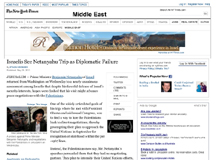Recent Entries:
Month: May 2011
May 31, 2011
NPR’s Diane Rehm Stacks the Deck Against Israel
Rehm and friend Diane Rehm has frequently stacked the deck against Israel in her NPR talk show. The latest example is her May 23 show, “President Obama, the Middle East, and the Arab Spring,” where she provided a platform for the anti-Israel rhetoric of Hisham Melhem, an anti-Israel polemicist employed as an Arab newspaper/television journalist. Melhem took advantage of his platform, criticizing Israeli Prime Minister Netanyahu in the most unprofessional way:
Look, this is Netanyahu. We know where Netanyahu comes from… President Bill Clinton … used the F-word [in the 1990s].
Melhem stridently warned:
If the Israelis don’t withdraw and allow a Palestinian state, in 20 years — let me tell you something in terms of demography — the majority of people who live in what is today Jordan, what is today West Bank and Gaza and Israel itself will be Palestinians. So you can kiss your Jewish state goodbye in that sense. It’s going to be ipso facto bi-national state, whether you like it or not. And engaging in ethnic cleansing today is not going to be easy.
Melhem’s premise of a Middle East demographic doomsday scenario where Arabs will greatly out-populate Jews, like his other assertions, was accepted without question. But an important challenge to this scenario was ignored (“[According to] United Nations’ population forecasts: At constant fertility, Israel will have more young people by the end of this century than either Turkey or Iran, and more than Germany, Italy or Spain…[and] if present trends continue, Israel will be able to field the largest land army in the Middle East.”).
Who represented Israeli views here? Certainly not any of the other guests: Jeremy Ben-Ami, president of J Street, which erroneously presents itself as a pro-Israel organization, Lisa Anderson, president of American University in Cairo or David Sanger, New York Times Middle East reporter.
It was another typical day at the office for Rehm and company – no one representing the Israeli position in a discussion of the Palestinian-Israeli conflict.
The Diane Rehm show can be contacted at 202-885-1231 or [email protected].
May 31, 2011
One thing in Arabic, Another in English … at MIT?
Was the translation accurate?One of the most common knocks against Arab leaders is that they say one thing in English to Western audiences and another thing in Arabic to their own supporters.
Sadly, it appears that this phenomenon has played itself out at the Center for International Studies (CIS) at the Massachusetts Institute of Technology.
First, some background.
Previously, Snapshots has written about a presentation that took place at MIT’s Center for International Studies (CIS) on April 29, 2011.
The presentation, which included speeches by two members of the April 6 Youth Movement that played a significant role in ousting Egyptian President Hosni Mubarak earlier this year, can be seen in its entirety here.
In a blog post titled, “Extremists Can Tweet, Too, Jason,” Snapshots lamented the failure of Jason Pontin, editor of MIT’s Technology Review to raise questions about the revolution that has taken place in Egypt. We wrote that with his “obsession on how activists used Facebook and Twitter to achieve Mubarak’s ouster, Pontin failed to ask some of the most basic questions about where the revolution is headed.”
In particular, Snapshots criticized Pontin for failing “to ask how Salafists and the Muslim Brotherhood are using the technologies the April 6th Youth Movement used to achieve Mubarak’s ouster.”
But wait, there’s more!
(more…)May 31, 2011
Border-Line Projection at the NY Times
On Friday, the New York Times published an editorial accusing others of twisting President Obama’s words:
Only a few minutes after President Obama finished his carefully balanced speech on the Middle East last week, Republican presidential candidates and lawmakers began twisting his words to suggest that he was calling for an epochal abandonment of Israel. . . .
Tim Pawlenty wrongly said Mr. Obama had called for Israel to return to its 1967 borders. . . .
That accusation is a bit rich considering that the New York Times was one of the major media outlets to first come out with fast and furious reports distorting Obama’s words.
As reported earlier by CAMERA, many mainstream media outlets, the New York Times among them, claimed that Obama called for an Israeli withdrawal to “1967 borders,” when his language correctly referred to “1967 lines.” (The difference is significant; No border existed between Israel and the West Bank before the 1967 war. The lines, established April 3, 1949 by Article III of the Israel-Jordan Armistice Agreement, are not borders but armistice lines, temporary boundaries to be replaced in the future by a negotiated, internationally recognized border.)
See, for instance, this article by Mark Landler and Steven Lee Myers, which, in the headline and repeatedly throughout the text inaccurately refers to “1967 borders” or “pre-1967 borders.”
The Times’ Helene Cooper was also a repeat offender, repeatedly distorting the President’s words.
Before pointing the finger at others, the New York Times should take a careful look at its own coverage.
(Hat tip: Mordy)
May 29, 2011
Federman “Fact-Checks” Netanyahu, Promotes Hamas
When will Federman fact-check Hamas?It has just come to our attention that the AP’s Mr. Josef “Fact Check Netanyahu” Federman cut Hamas some serious slack earlier in the month. In a May 13 piece entitled “Hamas sends signals of moderation to West” and coauthored with Ibrahim Barzak, Federman writes:
Hamas, the Islamic militant group known for suicide bombings, rocket attacks and hatred of Israel, is sending subtle signals of moderation as it prepares to join a Palestinian unity government.
Hamas officials speak of reconciliation with the West and a halt in armed hostilities with Israel, and even hint at some sort of political accommodation with the Jewish state.
While Israel is not convinced, there are hopes in some Palestinian circles that the Iran-backed group could become a more accepted part of the Mideast diplomatic equation.
“The world should realize that we have made many changes,” said Ghazi Hamad, the deputy foreign minister of the Hamas government in the Gaza Strip. “The international community should not run away from these changes.” . . .
Hamas has sent a series of signals recently aimed at showing that it will not be the reason for any new breakdown. While refusing to disarm or give up its “right to resist,” leaders – including Gaza Hamas Prime Minister Ismail Haniyeh in a speech last week – say they are committed to preserving “calm” with Israel. . . .
At a signing ceremony last week in Cairo, Mashaal referred to an independent Palestinian state in the West Bank and GAza STrip and made no references to Israel’s destruction.
Federman and Barzak cast no doubt, raise no questions, “check” no facts.
Two days later, Barzak filed a story covering Ismael Haniyeh’s “end the Zionist project in Palestine” speech. He wrote:
A Hamas leader has delivered a hard-line speech to thousands of Muslim worshippers commemorating the uprooting of Palestinians during the 1948 war over Israel’s creation.
Ismail Haniyeh said Sunday that Palestinians mark the occasion this year “with great hope of bringing to an end the Zionist project in Palestine.” He also affirmed the right to resist Israeli occupation.
Did the Hamas leader’s call for genocide — essentially a reiteration of a goal made plain in the group’s charter — prompt Federman to revisit his Hamas moderation story and re-check his facts? Apparently not.
May 29, 2011
In Ha’aretz, Conscious or Not?
Earlier this month, we flagged a Ha’aretz interview in which an Israeli Arab had an implausible memory of events that occurred before his birth. Now we have another example of implausible Arab testimony in Ha’aretz — this time it’s what the interviewee claims not to remember that does not add up.
On May 27, Amira Hass wrote about a Palestinian teen who suffered injuries including a fractured skull during his reportedly violent arrest on “Nakba Day” (“Teen hospitalized with fractured skull after violent Nakba Day arrest“). Her account is based on the testimony of the 15-year-old and his parents, including the following:
One of the policemen then knocked him unconscious with a rifle butt.
He said he was taken aboard a police jeep, from which he was removed at a gas station near the exit from the village. The police woke him up by pouring water on him, then beat him until he started spitting blood and lost consciousness again. He said he has no recollection of the next 24 hours, until he woke up Monday afternoon at Hadassah University Hospital, Ein Karem, surrounded by police.
Hass later quotes a spokeswoman for Hadassah Hospital, who counters:
Hadassah spokeswoman Yael Bosem Levy told Haaretz that A.A. arrived at the hospital fully conscious.
In other words, Hass reports the conflicting claims about whether or not the teen was conscious when he arrived at the hospital as a he said/she said dispute, in which the facts could not be determined.
And, yet, it was easily possible to determine which side was telling the truth. As Hass herself reports elsewhere in the article:
According to his discharge papers, A.A.’s condition on arriving at the hospital was as follows: drowsy, suffering from grade 8 pain (on a scale of 10 ), a bleeding scalp, subdural bleeding in the face and chest, scrapes on his back and multiple bruises on his limbs. A CAT scan found the boy had a cracked skull and a tear in his liver.
According to hospital records, the teen was “drowsy” — not unconscious — when he was admitted to the hospital. If he was not telling the truth about that aspect of his story, what else did he lie about?
(more…)May 26, 2011
LA Times Corrects Letter
The Los Angeles Times corrected the May 20, 2011 letter-to-the-editor which falsely stated a conservative Israeli newspaper removed Hillary Clinton from an official White House photograph. The paper was American. The error and correction follow:
Error (Los Angeles Times, Terrell Roberts, letter, 5/20/11): . . . .we just had a conservative newspaper in Israel delete Hillary Rodham Clinton’s image from the picture of Obama administration officials in the Situation Room during the Osama bin Laden raid. . .
Correction (5/26/11): Photograph: A May 20 letter to the editor incorrectly said a conservative Israeli newspaper digitally scrubbed Secretary of State Hillary Rodham Clinton from a photo of Obama administration officials monitoring the raid on Osama bin Laden. The newspaper that altered the photo is based in Brooklyn, N.Y.
May 26, 2011
NYT‘s Wishful Thinking Vs. Ha’aretz Poll
As we blogged yesterday, the New York Times headline “Israelis see Netanyahu Trip as Diplomatic Failure” was contradicted by a Dialog poll covered in Ha’aretz showing “47 percent of the Israeli public believes the U.S. trip was a success, while only 10 percent viewed it as a failure. ”
New York Times editors are likely wincing as they look at Ha’aretz‘s front-page today:
Versus the Times’ headline yesterday:
May 26, 2011
CNN Article Maps Out ’67 Lines Issues
This CNN article by Tim Lister does a commendable job explaining the status of the 1967 armistice line, an issue which is repeatedly misreported in the mainstream media. Lister writes, in part, that Netanyahu’s
choice of the word “boundaries” may not have been accidental, because in 1967 Israel had no agreed borders with its Arab neighbors. They were instead armistice lines agreed to in 1949 after the division of Palestine. (Internationally-recognized borders with Jordan and Egypt have since been agreed upon.) The Six Day War rendered those armistice lines redundant.
At the end of May 1967, Egypt, Syria and Jordan were massing troops and armor within striking distance of Israel. Egypt had closed the Straits of Tiran to Israeli shipping. On June 5, Israel launched a pre-emptive attack that destroyed much of the Egyptian air force. In the days that followed, Israeli forces captured all of Jerusalem and the West Bank from Jordan, the Golan Heights from Syria and the Sinai peninsula and Gaza from Egypt. Suddenly, Israel had some “strategic depth.”
May 25, 2011
For New York Times, 10 Percent Equals “Nearly Unanimous”
A May 25 online story in the New York Times is headlined, “Israelis See Netanyahu Trip as Diplomatic Failure.”
In it, correspondent Ethan Bronner writes that
Prime Minister Benjamin Netanyahu of Israel returned from Washington on Wednesday to a nearly unanimous assessment among Israelis that despite his forceful defense of Israel’s security interests, hopes were dashed that his visit might advance peace negotiations with the Palestinians.
Read the bolded section again. Now read the results of a poll commissioned by Ha’aretz and publicized, to the misfortune of the Times, shortly after Bronner’s piece:
The poll, conducted by the Dialog organization, under the supervision of Prof. Camil Fuchs of the Tel Aviv University Statistics Department, showed that 47 percent of the Israeli public believes the U.S. trip was a success, while only 10 percent viewed it as a failure.
The Times and other media organizations too often fail to capture the feelings, concerns and hopes of mainstream Israelis. This might be as close as we get to statistical evidence of that journalistic shortcoming.
(h/t Amspecblog.)
May 25, 2011
USA Today Hits Rare Media Bull’s-Eye
USA Today’s detailed feature article, “Israelis ambivalent about Arab world’s uprising; Some see opportunity for peace, prosperity; others fear onset of aggression” does what much coverage of Arab-Israeli developments does not: It treats Israelis as human beings with newsworthy concerns. In doing so, it also sheds light on what too many reports have misleadingly termed “Arab democracy movements.”
Writing in USA Today’s May 23 edition, correspondent Oren Dorell, tells readers that “Many Israelis …. look at the popular uprisings that began in Tunisia and have burned across the military backed dictatorships of North Africa and the sheikdoms of the Persian Gulf and see the resurrection of the Arab dream of destroying Israel.”
Dorell provides readers with a range of Israeli opinion, from both men and women in the street to that of academics and former senior officials: “‘God help us, you look at the map, it’s scary,’ says kindergarten teacher Liat Ben Yaacov ….” “‘You’re having very quickly a massive weakening of U.S. posture in the Middle East, with ally after ally falling by the wayside,’ [Caroline Glick, Jerusalem Post columnist] says. ‘As an Israeli looking at this, it’s terrifying.’”
The reporter quotes Arab protest leaders who underscore Israeli concerns: Though Egypt can’t confront Israel now, once it is strong, “‘the regional situation will be different because there will be Turkey, Egypt and Iran. When these three are strong and allies, Israel will chose to go away,’” says Tarek Khouly, “a coordinator for the April 6th youth movement in Cairo, [who] is illustrative of the mixed message being sent to Israel.” “Ayman Nour, president of the liberal Al Ghad Party in Egypt, says peace with Israel should be preserved. His son, Nour Ayman Nour, calls Israel ‘a fascist regime influenced by religion that wants to eradicate’ Palestinians.”
USA Today’s feature puts the Jewish state in regional context. Among other things, it notes: “Israel has more than 61 companies on NASDAQ [the high-tech stock market listing], more than the entire Arab world combined and trailing only the USA and China ….”, “Arabs living in Israel have more freedoms than their brethren in any Arab state, according to Freedom House, which advocates democracy around the world” and “For years, people in the Arab world have been fed a daily diet of anti-Israel propaganda … the U.S. State Department says.”
What seems to be a factual error, a reference to “the Arab military movement to wipe out the Jewish state in 1949, 1968 and 1972” probably refers to the wars of 1948, 1967 and 1973. Otherwise, “Israelis ambivalent about Arab world’s uprisings” is a timely, three-dimensional look at the Middle East through Israeli eyes, a rare counter-point to media default coverage of Israel through Palestinian Arab filters.
Search:
Search this site:







